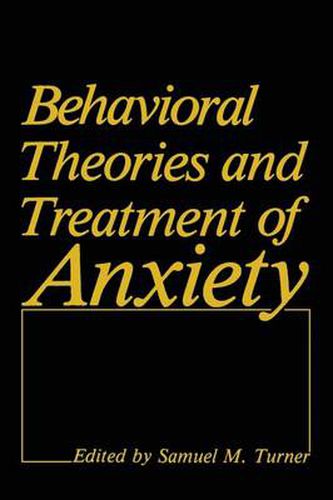Readings Newsletter
Become a Readings Member to make your shopping experience even easier.
Sign in or sign up for free!
You’re not far away from qualifying for FREE standard shipping within Australia
You’ve qualified for FREE standard shipping within Australia
The cart is loading…






This title is printed to order. This book may have been self-published. If so, we cannot guarantee the quality of the content. In the main most books will have gone through the editing process however some may not. We therefore suggest that you be aware of this before ordering this book. If in doubt check either the author or publisher’s details as we are unable to accept any returns unless they are faulty. Please contact us if you have any questions.
When behavior therapy was first applied to what would now be labeled an anxiety disorder, a simplistic theoretical model guided the treatment of a sim ple phobia. Time and research have shown that the techniques of behavior ther apy have been more successful than its models have been explanatory. Yet progress has been substantial in both realms, as the following volume makes patently clear. In 1980 an inventory of this progress was catalogued at an NIMH-sponsored workshop. What both that workshop and this volume clearly show is that the behav ior therapy researcher need no longer suffer the epithet overly simplistic. One of the major strengths of this volume is its elucidation of the complexities that now attend the study of the anxiety disorders, particularly from a behav ioral point of view. The researcher at times appears almost to be buried in a landslide of complexities regarding this topic. The concept of anxiety itself has undergone a differentiation to a level of complexity that poses problems for both the conceptualization and the treat ment of anxiety disorders. In virtually one voice, the several authors of this volume argue the multidimensional nature of anxiety. The lump view of anx iety has given way to the three-channel view of anxiety. An investigator’s future research career could well be secured just by spending time puzzling out the significance of the low intercorrelations among the channels.
$9.00 standard shipping within Australia
FREE standard shipping within Australia for orders over $100.00
Express & International shipping calculated at checkout
This title is printed to order. This book may have been self-published. If so, we cannot guarantee the quality of the content. In the main most books will have gone through the editing process however some may not. We therefore suggest that you be aware of this before ordering this book. If in doubt check either the author or publisher’s details as we are unable to accept any returns unless they are faulty. Please contact us if you have any questions.
When behavior therapy was first applied to what would now be labeled an anxiety disorder, a simplistic theoretical model guided the treatment of a sim ple phobia. Time and research have shown that the techniques of behavior ther apy have been more successful than its models have been explanatory. Yet progress has been substantial in both realms, as the following volume makes patently clear. In 1980 an inventory of this progress was catalogued at an NIMH-sponsored workshop. What both that workshop and this volume clearly show is that the behav ior therapy researcher need no longer suffer the epithet overly simplistic. One of the major strengths of this volume is its elucidation of the complexities that now attend the study of the anxiety disorders, particularly from a behav ioral point of view. The researcher at times appears almost to be buried in a landslide of complexities regarding this topic. The concept of anxiety itself has undergone a differentiation to a level of complexity that poses problems for both the conceptualization and the treat ment of anxiety disorders. In virtually one voice, the several authors of this volume argue the multidimensional nature of anxiety. The lump view of anx iety has given way to the three-channel view of anxiety. An investigator’s future research career could well be secured just by spending time puzzling out the significance of the low intercorrelations among the channels.